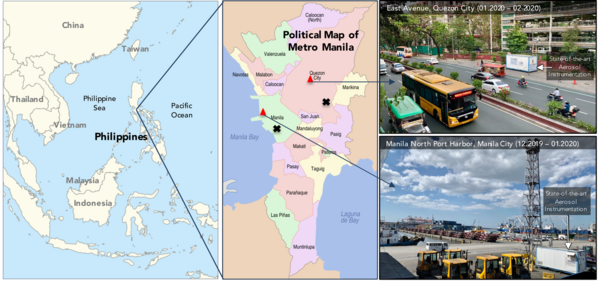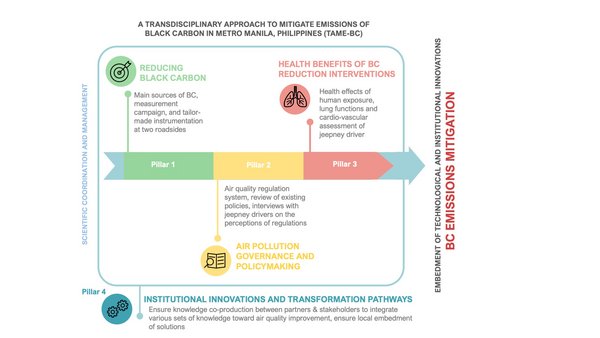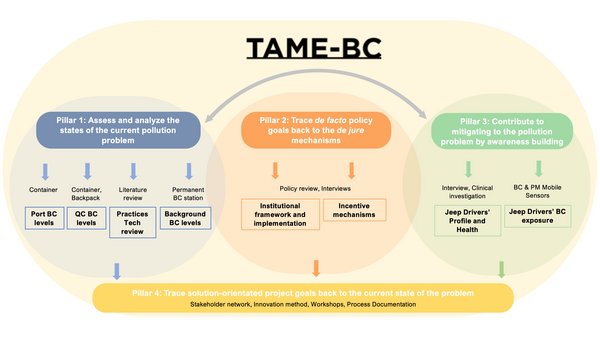TAME-BC
TAME-BC - Clean Air for a Sustainable Future: A Transdisciplinary Research Approach to Black Carbon Emissions Reduction in Metro Manila, Philippines
Partner Country: Philippines
Field of research: BC reduction in metropolitan region of Manila
Project duration: July 2019 - December 2020
Funding: BMBF
With 13 million inhabitants, Manila is one of the largest megacities in Southeast Asia. At the same time, the capital of the Philippines is one of the cities with the highest air pollution worldwide: soot pollution is about 50 times higher than found in Europe. The risk of developing lung cancer is about 1000 times higher. Environmental, social and health scientists from Germany and the Philippines worked together with NGOs, politicians and affected citizens to find sustainability solutions.
The aim of TAME-BC was to improve the living conditions for the people of Manila. The project also aimed to contribute to the United Nations' Agenda 2030 for Sustainable Development. The network, in which three institutes of the Leibniz Association were involved on the German side (the Leibniz Institute for Tropospheric Research (TROPOS), the Leibniz Centre for Marine Tropical Research (ZMT) and the Leibniz Research Institute for Environmental Medicine (IUF)), were funded by the Federal Ministry of Education and Research (BMBF) with a total of around 630,000 euros.
The research project TAME-BC, focused on a transdisciplinary approach to reduce black carbon (BC) emissions in Manila, Philippines.
The novel approach that was launched in 2019 integrates the natural, health, and social sciences in addressing the perennial problem of air pollution in Metro Manila.
TAME-BC provided a platform to gain a better understanding of the environmental impacts of BC and how to overcome the negative consequences by finding answers to the following research questions:
- What are the main sources of BC and how can we determine practices and technologies in the transport sector contributing to BC emissions?
- How can we assess the air quality regulation system, including the institutional work, the interplay of actors and institutions, and their rules and norms?
- How can we analyze and describe the potential health effects of human exposure to BC?
How can we integrate various sets of knowledge toward air quality improvement?
Bringing the four research pillars together in Metro Manila proved that custom-built technological solutions are necessary for high-quality data collection regarding air pollutants. Additionally, the high-quality data needs to be translated into the local context by analyzing de jure governance responses by state institutions and de facto mechanisms of the public down to the individual behavior of jeepney drivers. Third, awareness-building via knowledge on health effects needs to also be built with local stakeholders to guarantee sustainable change adaptation. Finally, these three scientific steps for BC emissions reduction need to be translated well into local networks, and therefore, a local partner is essential for innovation embedment via stakeholder engagement. These steps ensure a successful transdisciplinary approach for improved air quality and sustainable change-making. Such a setup has an impact on the local scientific state of the art (pillar one) through scientific emissions assessment, together with local partners. Applying the policy fore-, and back-casting assessment and awareness building pillars (pillars two and three) is also done. The fourth pillar has the potential to combine the knowledge produced toward the development of pollution mitigation.
Publications:
* Tõnisson L, Kunz Y, Kecorius S, Madueño L, Tamayo E G, Casanova D M, Zhao Q, Schikowski T, Hornidge A-K, Wiedensohler A, Macke A (2020) From Transfer to Knowledge Co-Production: A Transdisciplinary Research Approach to Reduce Black Carbon Emissions in Metro Manila, Philippines, Sustainability 2020, 12(23), 10043; https://doi.org/10.3390/su122310043



